How to Successfully Market Your Business Without Social Media

Yes, you can run a successful business without social media. With the right strategies in place, sustainable growth is more possible than ever.
Businesses thrive on word of mouth and nurturing deep customer relationships. Email list building and marketing, hosting community events, and SEO-optimized websites are also essential tactics.
These tactics allow you to establish trust, directly reach niche audiences, and save yourself from relying on ever-evolving social media platforms.
Taking the time to consider other options puts your business in a position to foster authentic engagement and lasting value.
This approach ensures you build the right foundation for sustainable growth.
On this page:
- Why Consider Marketing Without Social Media?
- Define Your Ideal Customer
- Marketing Beyond Social Media
- Proven Non-Social Media Marketing Strategies
- Alternative Digital Channels for Reach
- Building Authentic Brand Voice Online
- Measuring Success Without Social Metrics
- Operational Challenges and Solutions
- Key Points to Consider
Why Consider Marketing Without Social Media?
While marketing via social media platforms may feel like the low-hanging fruit, this shouldn’t be your end game.
Discover alternatives that are more aligned to your business objectives. Although social media provides a level of visibility that’s hard to fathom, for some businesses, the negatives outweigh these potential benefits.
Once you have a better idea of these challenges, you can find deeper and longer-lasting solutions.
Social Media’s Drawbacks and Limitations
One of the biggest worries for entrepreneurs is the fickle algorithms of social media platforms.
Instagram and Facebook are notorious for changing their algorithms often, making your valuable content invisible overnight. This leads businesses to explore various marketing options, sometimes forcing them to pay more for ads to appear.
This reality can also include account suspension, which poses a real risk for business owners who can’t afford to make their online presence a guessing game.
Maintaining a united brand voice across different marketing channels is another challenge.
Each platform requires a different style of content, which complicates branding efforts.
For instance, the messaging tone that works on TikTok doesn’t necessarily translate to LinkedIn, leading to inconsistent messaging that can affect brand awareness.
Entrepreneurs must navigate these complexities to ensure their marketing tools effectively reach their ideal clients.
The need for a cohesive strategy is paramount, especially when running a web design business or any online business.
As social media evolves, adopting alternative marketing strategies can help businesses stay relevant and connect with their audience effectively.
This is crucial for fostering engagement and ensuring that valuable content reaches potential customers without getting lost in the social media grind.
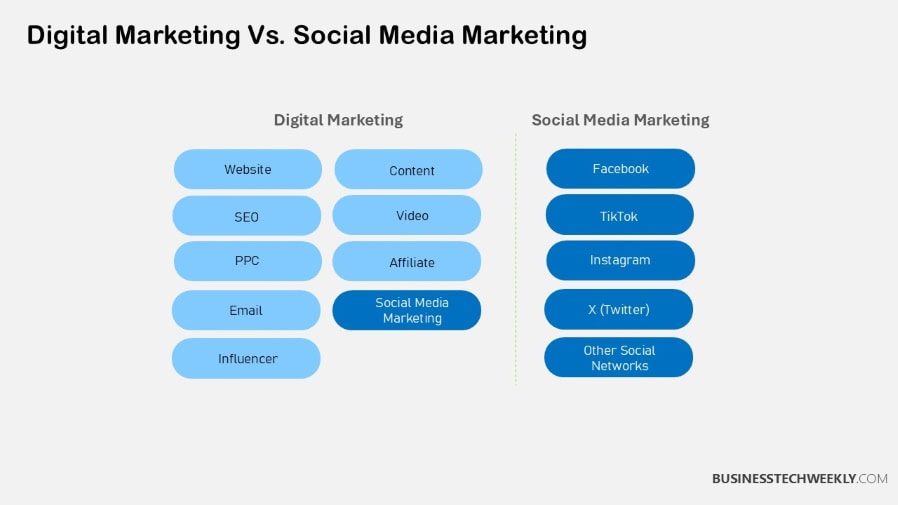
Reaching Over-Saturated Audiences
With the exception of LinkedIn, social media spaces are extremely crowded and therefore extremely competitive spaces.
Fighting against millions of other businesses means all her well-produced content will be buried in the feed, even if it’s perfect.
Instead, think about how you can reach those niche audiences beyond social media.
Email marketing, as one example, puts you directly in front of your audience without algorithms getting involved.
Podcasts—when optimized with SEO to maximize visibility—are another long-game organic growth strategy, just ask any show with noticeable podcast spikes over time. Well-crafted, targeted messages make the difference, too.
By leveraging rich, detailed customer personas, you can serve something truly engaging and valuable to those segments that align best with your goals.
This strategy minimizes wasted effort by making sure your message reaches the right folks, even when they’re not on dominant platforms.
Regaining Control of Your Brand Message
Begin by developing a complete picture of your perfect customer. Tools such as surveys or analytics can help identify who your audience is and what they want.
Take, for example, the importance of knowing what motivates your audience — with this knowledge, you can create proactive campaigns that resonate with your target audience’s needs.
Customer personas take it a step further by merging this data with psychographics.
These fictional profiles inform your strategy, helping to make sure every touchpoint aligns with the essence of what your brand stands for.
Content marketing can generate up to three times more leads at 62% lower cost compared to traditional outbound tactics.
Define Your Ideal Customer
The foundation of any successful business is understanding your ideal customers.
Knowing who they are, what they value, and how they interact with businesses allows you to craft a marketing strategy that truly resonates.
This clarity will help your marketing options cut through the noise and connect meaningfully, delivering an impact that goes far beyond temporary social media posts.
Identify Core Customer Values
These values shape every decision your customers make. To identify these, think about directly researching your existing customers through surveys or interviews—or even going back and reviewing long-ago customer feedback.
Identify common threads—maybe they care about cost, environmental impact, or are seeking added flexibility.
For instance, a small business that sells sustainable packaging may discover their ideal customer prioritizes sustainability over acquiring an inexpensive option.
After recognizing these values, create a brand mission to embody them and start the new narrative as genuinely as possible.
If transparency is a key value of your audience, including a glimpse into your sourcing process or ethical practices can help establish that trust.
Showcasing these common values on your homepage or through your email newsletter further strengthens this bond.
This means a SaaS company with a target of serving startups can own simplicity in its messaging. This approach meets the widespread desire to find more cost-effective solutions.
Understand Customer Pain Points
Your customers’ challenges are your opportunities to make your business stand out.
Begin by defining the shared pain points from background research or direct interviews. If buyers often complain that they can’t understand complex return policies, providing an easy return process will help you win.
Acknowledge these concerns right in your presentation. If a logistics company recognizes its clients need faster delivery updates, providing real-time tracking in emails or text updates can improve satisfaction.
Creating these personalized solutions not only strikes a chord but makes your business one to remember.
Map Customer Journey
Mapping your customer journey allows you to identify how and when you should reach out to them at every stage.
Map it all out, from first discovering your brand through to completing a purchase.
For instance, a conversion-driven professional services firm may find their target audience initially looks for helpful educational information before making a long-term commitment.
Providing more in-depth resources, such as whitepapers or webinars during this phase helps to build credibility and trust.
Outside of digital media, consider more traditional approaches such as direct mail campaigns or partner with other organizations.
Pairing these tactics together, like using email newsletters alongside local sponsorships, widens your scope of influence and lowers the risk of being dependent on one major source.
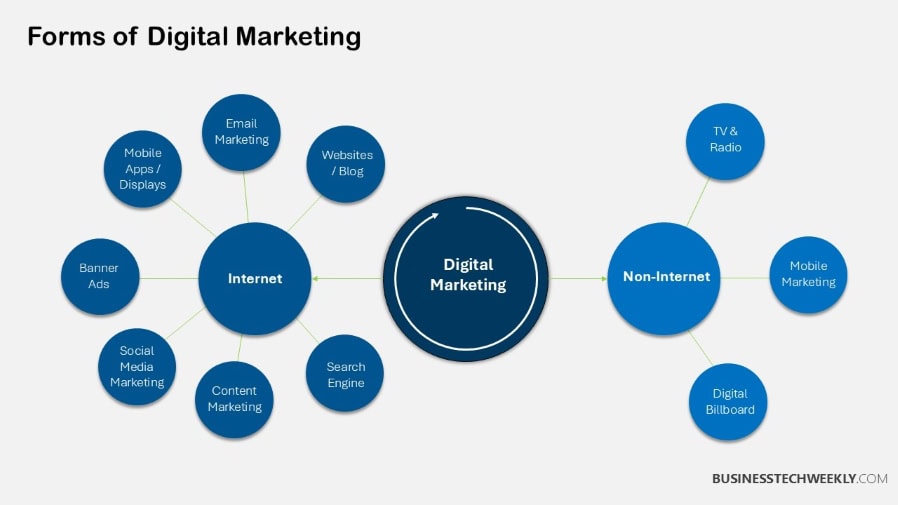
Marketing Beyond Social Media
Exploring marketing strategies outside social media opens up opportunities to diversify your outreach and build a resilient foundation for growth.
By weighing the risks and rewards, aligning efforts with your business goals, and managing budgets effectively, you can create a robust plan that ensures long-term sustainability.
Here’s what that means in plain English.
Risks and Rewards of Each Strategy
Every marketing tactic has risks and rewards. Paid advertising platforms such as Google Ads offer instant exposure to a wide-ranging audience.
Like reallocation, they require disciplined management of budgets to keep from going over budget.
Search engine optimization (SEO), responsible for over half of online traffic (53.3%), demands consistent effort but can yield high returns in organic visibility.
Referral programs, in which a commission incentivizes word-of-mouth promotion, entail low upfront costs but are at the mercy of customer satisfaction.
Organizing regular events or speaking appearances can build tremendous credibility and name recognition, but the logistical issues can be daunting.
Podcasts are another avenue, connecting you with targeted audiences while building authority, but success often hinges on quality content and regular production.
Understanding these risks allows for more informed decision-making, helping you to reduce the risks while you maximize and capture the rewards.
Aligning Strategies with Business Goals
Each marketing initiative needs to clearly tie back to your main goals. Start with clear, quantifiable objectives—be it boosting web traffic, building leads, or enhancing sales.
Developing high-quality content such as blogs, how-to’s, or other resources helps educate your target audience and supports your SEO objectives.
It builds credibility and trust with your audience. Just like any other component of your business, you should regularly step back, review and revise your approaches here.
Moving your marketing efforts away from general advertising and into presenting at relevant industry conferences will benefit your brand establishment and positioning.
The deeper your expertise, the more powerful this strategy is.
Aligning your marketing tactics to your overarching marketing goals and business objectives keeps your marketing efforts focused and flexible.
Budget Considerations for Each Tool
Marketing beyond social media takes careful planning and budgeting.
Forecast costs related to each channel—all the way from SEO tools, to producing a podcast, or sponsoring an event—and balance upfront costs with long-term ROI.
For example, investing in certain SEO strategies can lead to long-term benefits, while marketing heavily around one-off events may require ongoing investments.
Take a data-driven approach to prioritize spending by ROI.
If your audience frequently uses search engines, focusing on SEO or Google Ads might yield better returns than broader strategies.
Implementing a smart, balanced approach would target resources to the most critical needs and protect taxpayers from the worst financial exposure.
Consumers find user-generated content to be 35% more memorable and 50% more trusted than traditional media and non-UGC content.
Proven Non-Social Media Marketing Strategies
Social media often dominates conversations around digital marketing, but many entrepreneurs overlook effective marketing options beyond this realm.
The good news is that there are plenty of other proven, non-social media strategies to grow your business, such as leveraging a business blog or exploring alternative marketing strategies.
By focusing on these methods, you can build a sustainable, scalable marketing approach that aligns with your goals and audience.
1. Optimize for Search Engines (SEO)
SEO is still the bedrock of any strategy to attract free traffic from search engines.
Begin by doing keyword research to identify the keywords your target audience is already searching for. Tools such as Google Keyword Planner or SEMrush are great for this.
Use these keywords in your website copy, meta descriptions, and page headers to rank higher in search results.
Consistently adding new, valuable content to your site tells search algorithms you’re relevant, helping you maintain a good rank and visibility over time.
Take, for example, an organized FAQ page that responds to potential customers’ questions as well as ranking opportunities for long-tail keywords.
2. Content Marketing: Blogs and Articles
Blogs are one of the best means ever invented for sharing knowledge, establishing thought leadership, and earning expertise.
Attraction content Create useful evergreen topics like guides and how-tos that are always in demand and boost your brand authority.
For example, an ecommerce software provider could create content on topics like “How to Choose the Right Payment Gateway for Your Online Store.”
Create valuable resources to answer questions on your blog.
This strategy nurtures trust without requiring an upfront commitment.
Furthermore, it increases the website traffic and engagement by linking to your other pages.
3. Email Marketing: Nurture Leads
Email marketing is one of the few channels where you have direct access to your audience.
To optimize your email marketing, consider these best practices:
- Segment your email list to deliver personalized messages.
- Each email you send should have a specific purpose or message.
- Automated sequences, such as welcome or abandoned cart emails, do a great job of nurturing your leads.
For example, a SaaS company could send a series of emails highlighting features, testimonials, and case studies to convert free users into paying customers.
Email marketing is a great way to announce events, new products, special offers, and more.
4. Strategic Networking: Build Connections
Networking is one of the most overlooked tools available for growing your business. Join conferences and industry meet-ups to connect with your prospective clients and partners.
Public speaking, particularly at industry events where your ideal customer is in attendance, can help establish you as a thought leader to this audience.
Don’t underestimate the power of your own network—most of these early opportunities are found in your backyard.
This is a good reason to follow up every time to keep relationships active and meaningful.
5. Referral Programs: Word-of-Mouth Power
Happy customers have the potential to be your greatest champions.
Create a referral program with incentives, such as a 10% commission for referrals, to encourage them to spread the word.
Monitor your results in order to determine which of your customers are generating you the best business.
Think of it this way: happy interactions your customers post online can do wonders.
We all know that word-of-mouth is one of the most astonishingly effective and trustworthy forms of marketing.
6. Guest Blogging: Expand Your Reach
With guest blogging, you can leverage already established audiences. Find influential blogs in your niche and reach out with content ideas that will benefit their readers.
For example, a fintech software company could research or forecast “The Future of Small Business Lending” to be featured on a finance industry blog.
Guest posts build backlinks, improving your SEO and online visibility.
7. Podcasts: Share Expertise
Podcasts are a great medium to share thought leadership and connect with your audience in a much more personal way.
Launching your podcast helps you become an authority, but working with the podcasters already out there is one of the best ways to reach new audiences.
For instance, if you earn an interview on a podcast that has 10,000 regular listeners, that means your brand is being presented to a very engaged audience.
Share episodes via email and your website to further reach audiences where they are.
8. Public Relations: Earn Media Coverage
With a smartly conceived PR game plan, you may be able to create some terrific earned media coverage.
Whenever you accomplish a milestone, such as launching a new product or hosting a notable event, put together an exciting press release to grab journalists’ attention.
Developing relationships with reporters and journalists can result in inclusions or interviews, positioning you as an expert and improving your credibility.
9. Community Involvement: Local Engagement
Partnering and engaging with your local community helps create a positive brand image. Get involved with and support local events to improve visibility.
For example, if you collaborate with a local nonprofit, it comes across that your business is socially responsible.
Work with other local, small businesses to develop revenue-enhancing opportunities that benefit all parties, like cross-promotions or collaborative events.
10. Print Advertising: Targeted Campaigns
Print ads remain effective for reaching specific demographics.
For example, placing an ad in a niche magazine can put your business in front of 100,000 readers.
Design clear, visually appealing ads that reflect your brand.
Always measure results, whether through unique coupon codes or direct inquiries, to determine impact.
11. Diversify Digital Marketing
Discover new digital tactics that aren’t social media marketing.
Platforms such as Product Hunt or Reddit offer you an excellent opportunity to present your offerings directly to engaged audiences.
Mixing these with intentional email campaigns, SEO strategies, and content marketing creates an effective and influential digital ecosystem.
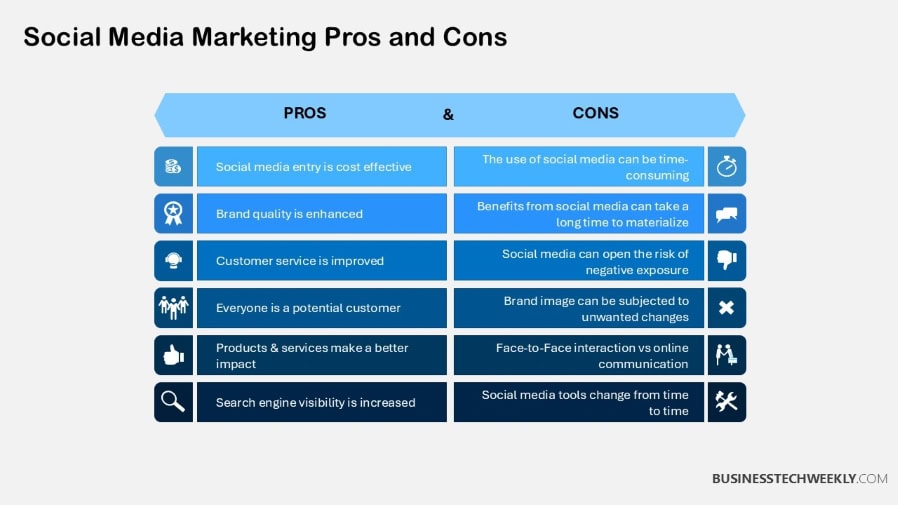
Alternative Digital Channels for Reach
Navigating the digital landscape without social media opens up transformative opportunities.
It’s a medium where you can reach ranks and audiences in direct, personal and thoughtful ways. Leverage other digital platforms to create authentic connections.
With this approach, you’re able to build credibility and increase your reach without doing battle in the often-crowded social media feeds.
Niche Online Communities and Forums
Engaging with niche communities offers a focused way to connect with people who share specific interests or challenges relevant to your business.
Once you pinpoint discussion hubs or digital spaces where your audience convenes, you can insert yourself in the conversation—serving as a helpful guide and trusted resource.
If a SaaS company primarily serving small businesses wanted to reach them, it could participate in entrepreneurial communities such as Indie Hackers or relevant subreddits.
This is why active participation is so essential.
Providing sage advice in reply to threads or conducting old school Q&A sessions directly on the channels can do both—showcase your expertise and develop the relationship.
Anything that’s useful and informative—whether that’s best practices or advice on more efficient workflows or example case studies—further builds your credibility.
Long term, all of these initiatives can foster organic referral or co-creation relationships.
Word-of-mouth recommendations are still the most effective channel too, with 92% of consumers trusting their peers more than any form of advertisement. When fostered, communities can organically help scale this trust.
Influencer Marketing (Without Social Media)
Influencer partnerships don’t need to be at the mercy of social platforms.
Partnering with those who already possess robust networks offline can prove to be transformative. This is everyone from thought leaders, to local event organizers, to authors.
For example, a consumer-focused fintech startup could collaborate with a popular personal finance expert to co-sponsor financial wellness workshops or webinars.
Look for shared values, not just shared demographics, to build genuine relationships.
Customers identify with partners who are authentic, not just chasing a transaction.
A perfect case in point here is Marks & Spencer’s long-running partnership with Breast Cancer Now.
This relationship is a great example of how brand purpose can increase brand trust.
Paid Advertising (Search and Display)
Digital advertising still gives you precision targeting capabilities and the flexibility to pivot on the fly.
Social media, search, and display ads can be hyper-targeted to specific individuals and use eye-catching messaging to engage them.
Writing familiar, fun, attention-grabbing ad copy that speaks to user pain points or interests increases the likelihood of higher click-through rates.
Regularly monitoring performance will help keep campaigns focused on what is working.
Tactical, data-driven adjustments such as when to refine targeted keywords or test variations of visuals can all help maximize results.
Digital ads, too, nicely augment other channels, such as email marketing, that allow for a no-distraction zone for targeted direct communication.
Combined, they form a powerful, yet deliberate strategy.
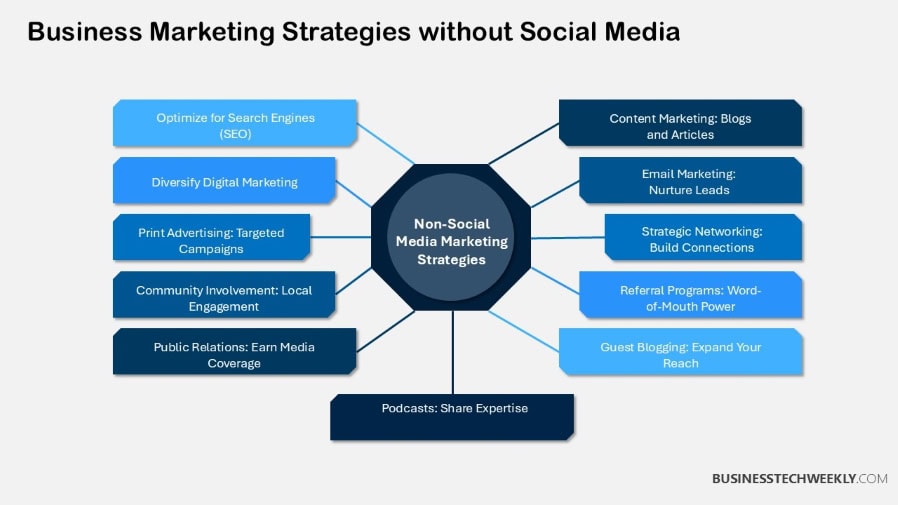
Building Authentic Brand Voice Online
Whether you’re new to social media or building a brand voice from scratch, building an authentic brand voice online is critical.
It’s the foundation for you to engage with your audience in relevant ways, develop memorable brand experiences, and establish invaluable brand loyalty.
By prioritizing authenticity and engagement, you can create a powerful online presence that truly connects with your customers.
Creating a Unique Brand Story
Authentically, your brand story should be an extension of that mission, values, purpose.
When you show the inspiration or passion behind your work, customers can identify with your story.
Feature actual individuals—full-time employees, company founders, or delighted customers—to bring humanity to the brand.
Say, for instance, that you operate a local bakery—tell the story of how the founder’s childhood recipes inspired their menu, producing nostalgia and connection.
Harness the elements of storytelling to create an emotional response. Feature touches such as customer stories or behind-the-scenes looks at your team and culture.
This helps you stand apart as a brand and want to build relatability.
Feature this story regularly on different platforms — such as your website, email, and even in collateral like brochures — to help build familiarity.
Fostering Customer Interaction on Forums
Engagement is a two-way street. Participate in forums or industry-specific platforms to engage with your audience on a more personal level.
Promote conversations on subjects that interest them like how to use your product most effectively, or trends in the industry.
For instance, brand-related software developers can create Q&A threads on relevant tech forums to help solve issues their potential customers are grappling with.
Responding to questions and comments in a timely manner helps build trust by demonstrating that you respect your audience’s time and concerns.
This makes people trust and be loyal to your brand. Build an open forum where your consumers can express their needs—be it via online polls, in-market surveys, or comment sections.
A warm, inviting space encourages contribution, allowing you to get a clearer picture of your audience’s most pertinent needs.
Encouraging User-Generated Content
User-generated content (UGC) makes ambassadors out of your customers.
Get them to start posting their own experiences of them using your products/services.
For example, a fashion retailer might encourage consumers to use the hashtag to share pictures of themselves wearing its outfits.
Place this badge on your website or in your marketing collateral to build credibility and encourage community.
UGC not only increases the variety of content but increases engagement and can drive valuable conversations.
Putting the spotlight on authentic customer experiences goes a long way toward making your brand feel more human and trustworthy.
Giving them an ear and the ability to be agile based on feedback is what cements these relationships even more.
Email marketing remains a powerful tool, with an average return on investment (ROI) of $42 for every dollar spent.
Measuring Success Without Social Metrics
Constructing a business that doesn’t depend on social media means rethinking how you measure success.
By employing effective marketing options and data-driven approaches, you can measure success more accurately, ensuring your marketing tools and strategies contribute to what really matters.
Tracking Website Traffic and Conversions
With your website being one of the most important touchpoints for potential customers, measuring its success is just as important.
Analytics tools like Google Analytics provide insights into user behavior, including page views, time spent on site, and bounce rates.
These performance metrics show you how visitors engage with your content, informing you where to drive improvement efforts.
To evaluate how well your different marketing options are performing, tracking conversions becomes vital.
For instance, if you’re managing a PPC (pay-per-click) ad program, measuring actions like sales or registrations is key. This metric reveals how relevant your ads are to your target audience, which is crucial for effective business growth.
Ensure your goals align with the SMART framework—specific, measurable, achievable, relevant, time-bound—to provide clarity and direction.
By reviewing this data, you can make informed adjustments to your marketing channels, such as selecting specific keywords or refining ad copy for more impactful results.
Monitoring Email Engagement and ROI
Email marketing is still one of the most effective ways to reach your members.
Tracking email open rates, click-through rates, and conversions from email campaigns give you such a black-and-white picture of engagement. If your email has a 30% open rate, congratulations—you’re starting from a high bar.
At just a 5% click-through rate, we know something’s gotta give. To determine ROI, simply divide the revenue that the campaign has generated by the cost of the campaign.
For instance, if you spend $500 on an email campaign and bring in $2,000 in sales as a direct result, that’s a 300% ROI.
These insights help you optimize email subject lines, better segment and score your audience, and find the best targeting strategy.
Analyzing Customer Feedback and Surveys
Having a deep knowledge of your customers is critical to being competitive in today’s world.
Surveys provide decision-makers with a direct pipeline to customer preferences and pain points.
Perhaps a survey shows that the one thing your customers want is lightning quick delivery which would allow you to refocus your logistics investments.
Beyond improving satisfaction, acting on this feedback creates loyalty.
Learning from Social-Free Businesses
Most businesses do perfectly well not needing social media, focusing on search engines, email marketing, and getting in front of their customers directly.
Since 90% of online experiences start with a search engine, making sure your website is optimized for search traffic is important.
Research proven success stories to find transferable tactics that will work for your business.
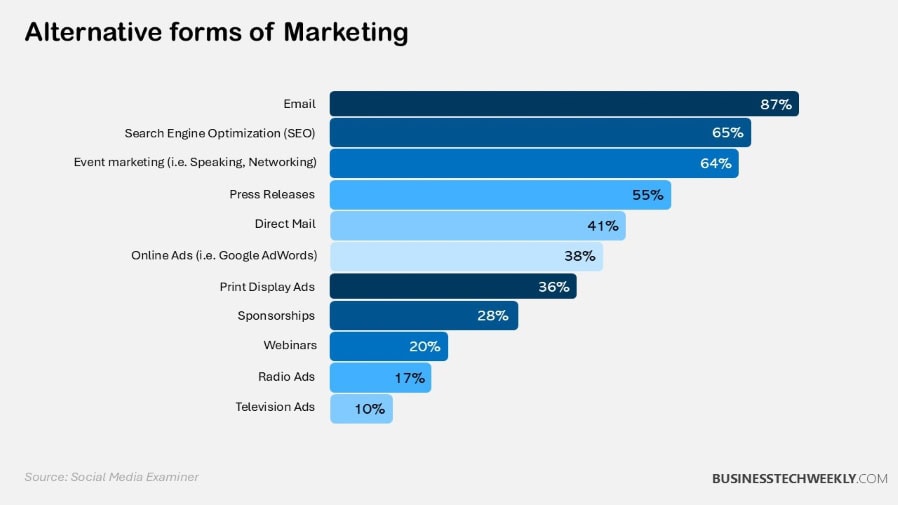
Operational Challenges and Solutions
Transitioning from a world dominated by social media to one without requires a poignant marketing strategy and agility.
By prioritizing unconventional business strategies, brands can establish a long-term, sustainable brand awareness, rather than continually chasing the next shiny object.
Time Investment in Alternative Strategies
Executing non-social media driven marketing strategies requires a greater upfront investment of time.
Channels such as referral marketing, direct mail, and email campaigns all have different timelines. For instance, referral marketing can yield high-quality leads.
78% of marketers report “good” or “excellent” results, but it requires setting up systems to track referrals and offering incentives, such as a 10% commission for services or a 30-70% commission for products.
Direct mail campaigns, even through Every Door Direct Mail (EDDM) are a great resource.
Though it is labor-intensive to create and share materials on the front end, this approach can go a long way in reaching communities directly.
Unlike large corporations, small businesses have the unique ability to leverage their hyper-local connections to establish trust and engagement.
Email campaigns can be quickly deployed but benefit from pre-planned sequences, such as sending pre-sale notices to loyal customers who’ve shown interest in specific products.
Creating a timeline for these activities ensures efficient execution and avoids overwhelming your resources.
Skill Sets Required for Implementation
In order to implement these strategies, your team will require a certain skill set.
Graphic design goes into creating print materials just for direct mail. Developing appealing referral incentives requires professional copywriting skills.
If these skills aren’t in-house, look to train or bring those experts on board.
Continuous improvement is equally important. The marketing landscape is changing all the time.
Being ahead of the curve on ideas such as email automation and community-based marketing will set you apart from your peers.
By taking a proactive approach like this, your team can stay efficient and even supercharged.
Maintaining Consistency Across Channels
From your website pages to SMS text campaigns, consistency is crucial in creating consistency with your brand throughout all marketing initiatives.
First, set brand guidelines and consistently proof all materials to create a cohesive message across boards.
Coordination between each team member’s work is critical to prevent operation/functionality alignment from going off the rails.
Unified inbox management is essential.
An effective centralized inbox management system can make communication easier, faster, and more convenient—all in one place, across channels.
Key Points to Consider
Operating a business without social media isn’t just possible—it can be the best decision if done correctly.
It allows you to invest in building more meaningful relationships with specific audience.
- Not to mention the risks of social media marketing – shutting down accounts, losing access to data, and audience fatigue are big issues. By exploring alternatives, you can put yourself back in the driver’s seat and get digital marketing back on a stable course.
- Determine who your ideal prospects are by knowing what they value, what their biggest challenges are, and what their needs are. Find messaging hooks that align with their gospel principles and core values to gain trust and foster long-term relationships.
- By mapping out the customer journey, you’ll be better equipped to identify key engagement touchpoints. Leverage this customer knowledge to improve the customer experience and develop focused, optimized strategies.
- Optimize your marketing strategy with targeted SEO tactics, drip email campaigns, content marketing, and in-person networking opportunities. All of these tactics can easily allow you to connect with your target audience outside of social media.
- Analyze the effectiveness of your marketing visualizing KPIs, collecting customer feedback, and monitoring ROI. By using these insights to inform your campaigns, you can better focus your efforts and drive more valuable outcomes.
- Look at other businesses that are doing well without relying on social media. Take their approaches—like genuine narrative-building or robust civic engagement—and adapt them to your own business architecture.

